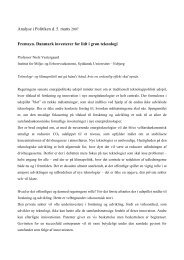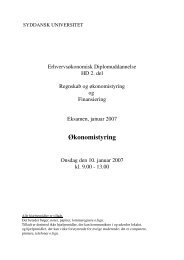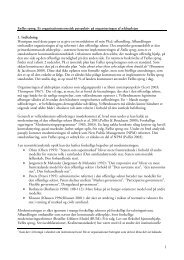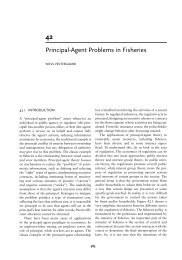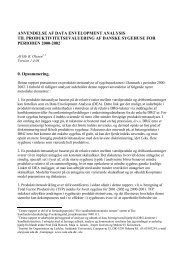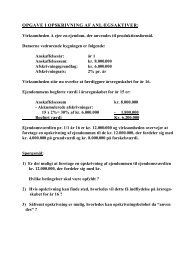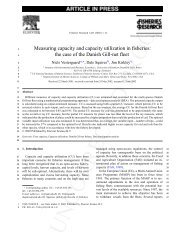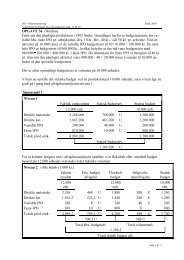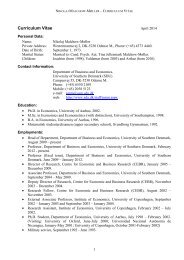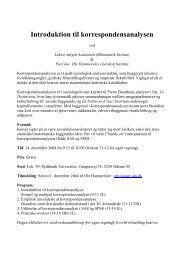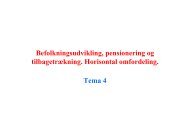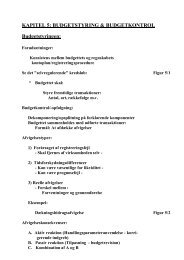place after talks with each applicant. About one third were former members <strong>of</strong> PZPR, but amongthe new members, we also f<strong>in</strong>d many young people. Back <strong>in</strong> the 1980’s most former members <strong>of</strong>PZPR <strong>and</strong> to day SLD-members had been reform-communists, at that time support<strong>in</strong>g politicalreforms <strong>and</strong> subsequently pav<strong>in</strong>g the way for the round table negotiations with the opposition <strong>in</strong>1988-1989.Wojciech Pielecki expressed the op<strong>in</strong>ion that young people jo<strong>in</strong>ed the party not because <strong>of</strong> theirattitudes to the past, but because <strong>of</strong> their personal conviction about Pol<strong>and</strong>’s future. The past theyleft to the historians 87 . Therefore, he argued, SLD can no longer be considered as a party mostlyappeal<strong>in</strong>g to pensioners <strong>and</strong> former communists. 60 pct. <strong>of</strong> those vot<strong>in</strong>g on SLD <strong>in</strong> late 1990s, wereunder 40 years <strong>and</strong> therefore had no stake <strong>in</strong> the old system. A political learn<strong>in</strong>g process had takenplace s<strong>in</strong>ce 1989. The choice <strong>of</strong> “new-old” party members were pragmatic, almost value free. Manywere engaged <strong>in</strong> the new private sector <strong>and</strong> had voted on Solidarity at the first elections, but theychanged op<strong>in</strong>ion <strong>and</strong> left Solidarity disappo<strong>in</strong>ted because <strong>of</strong> the bad political style <strong>and</strong> policy-l<strong>in</strong>e.Accord<strong>in</strong>g to Pielecki, the fact that the communist past no longer played a big role was primarilydue to psychological factors. A more “cool” evaluation <strong>of</strong> the past, the period <strong>of</strong> real socialism<strong>in</strong>cluded, was needed. People were almost overwhelmed by so many great changes <strong>in</strong> society that<strong>in</strong>evitably the memories <strong>of</strong> the time before 1989 receded <strong>in</strong> the background. Therefore “a newauthentic thick l<strong>in</strong>e” towards the past had to be drawn like <strong>in</strong> the case <strong>in</strong> Spa<strong>in</strong> after Franco. Thatwould open up for new more fruitful political alliances, maybe a historical compromise betweenSLD <strong>and</strong> the Freedom Union (UW). In pr<strong>in</strong>ciple SLD’s coalition potential was great as the barriersfor a historical compromise between SLD <strong>and</strong> UW were historical <strong>and</strong> only to a small extentpolicy-related.At the 2001 election no less than 3.5 mil. young Poles could vote for the first time. So the politicalparties tried to appeal to young voters who <strong>of</strong>ten did not move to the ballot box. Accord<strong>in</strong>g topublic op<strong>in</strong>ion polls about 40 pct. <strong>of</strong> the first time voters would vote SLD. Thus SLD had alsobecome a “party <strong>of</strong> the youth”. SLD obta<strong>in</strong>ed the greatest support <strong>in</strong> all important social groupsirrespective <strong>of</strong> sex, age, education, means, work<strong>in</strong>g place <strong>and</strong> home place. At the earlier electionsthe majority <strong>of</strong> best educate had decided to vote the Freedom Union (UW), now the same majorityvoted SLD. Opposite SLD’s then strongest political rival, the right w<strong>in</strong>g AWS, had the greatestelectoral support among older people, private entrepreneurs <strong>and</strong> people with short-term education<strong>and</strong> tra<strong>in</strong><strong>in</strong>g.The programme proposal put forward at the 1999 found<strong>in</strong>g congress underl<strong>in</strong>ed that no “third way”existed between planned economy <strong>and</strong> market economy. As put by the chairman for the programmecommission, Andrzej Cel<strong>in</strong>ski, the pathway <strong>in</strong> the economic policy had been laid already <strong>in</strong> the“Balcerowicz plan I”, set <strong>in</strong> motion shortly just after the formation <strong>of</strong> the first Solidarity-ledgovernment <strong>in</strong> 1989. Only m<strong>in</strong>or adjustments <strong>in</strong> that plan were possible. Thus, only smalldifferences existed between the policy <strong>of</strong> the neo-liberal Leszek Balcerowicz <strong>and</strong> the left w<strong>in</strong>geconomist <strong>and</strong> later prime m<strong>in</strong>ister Marek Belka. Nevertheless, Cel<strong>in</strong>ski argues, the Left is obligedto give the socially weakest <strong>in</strong> society a new chance <strong>and</strong> equalize the far too big regionaldifferences <strong>in</strong> social welfare.87 Rzeczpospolita 23 August, 1999:A2 <strong>and</strong> Wojciech Pielecki, ”Trup niezgody”, Gazeta Wyborcza, 15 November, 1999<strong>and</strong> my own <strong>in</strong>terview with SLDs Tadeusz Iw<strong>in</strong>ski, Warsaw 20 October 1999.94
The declarations stressed that SLD should l<strong>in</strong>k itself to the historical traditions <strong>in</strong> the Polish <strong>and</strong>European socialist movement, thereby underl<strong>in</strong><strong>in</strong>g the connections go<strong>in</strong>g back to the traditions <strong>and</strong>the political th<strong>in</strong>k<strong>in</strong>g on the European Left. The day-to-day politics should be based on a fruitful<strong>in</strong>teraction between patriotism, <strong>in</strong>dependence <strong>and</strong> protection <strong>of</strong> human <strong>and</strong> social rights. On thatbasis the party should make use <strong>of</strong> the pr<strong>in</strong>ciples about social justice, freedom <strong>and</strong> self-government.The attitudes to the past was much debated at the found<strong>in</strong>g congress <strong>and</strong> therefore followed withgreat attention by the public. In the programme proposal the crimes <strong>of</strong> Stal<strong>in</strong>ism were condemned<strong>and</strong> the lack <strong>of</strong> democracy deplored referr<strong>in</strong>g to the “economic pathology” <strong>and</strong> the limitations <strong>in</strong> thecivil rights. Nevertheless, it was said, SLD appreciate those, who under the old system <strong>in</strong> honestways contributed to ris<strong>in</strong>g the material wealth through their hard work. In a resolution adopted atthe congress SLD dissociated itself from the communist totalitarianism <strong>and</strong> crimes that had<strong>of</strong>fended the ma<strong>in</strong> ideals <strong>of</strong> the Left. The party was also ready to pay economic compensation tovictims <strong>of</strong> Stal<strong>in</strong>ism. Accord<strong>in</strong>g the Leszek Miller the evaluation <strong>of</strong> the past should be “severe, butfair”.The exact formulations <strong>of</strong> the programme were discussed dur<strong>in</strong>g the found<strong>in</strong>g congress. Thoseformulations that were adopted, did not satisfy all, primarily because the political <strong>and</strong> economicconditions before 1989 were not mentioned directly <strong>in</strong> the resolutions adopted. Before the congressopened <strong>and</strong>, without the SLD-leaderships knowledge, Aleks<strong>and</strong>er Kwasniewski had read outthrough a spokesman a letter to the delegates, <strong>in</strong> which he asked the party to break with the past notonly symbolically but radically <strong>and</strong> <strong>in</strong>-depth. The many questions about the reckon<strong>in</strong>g with the pastwas reactivated as AWS presented a law proposal that tightened exist<strong>in</strong>g lustration-laws. Thatproposal was, however, rejected by the majority <strong>in</strong> the parliament, <strong>in</strong>clud<strong>in</strong>g the Freedom Union(UW). Had the proposal from AWS been adopted, it no doubt would have been met by a veto fromthe president primarily due to the legal problems connected to the proposal. Thus despite size,organisational strength <strong>and</strong> <strong>in</strong>ternal transformation SLD still constituted an axis <strong>of</strong> polarisation <strong>in</strong>Polish politics.Important was to limit the waste <strong>of</strong> votes. Therefore SLD encouraged the Labour Union (UP) tonom<strong>in</strong>ate c<strong>and</strong>idates on the party’s lists at the election <strong>in</strong> autumn 2001. Accord<strong>in</strong>g to op<strong>in</strong>ion pollsUP was <strong>in</strong> risk not to be represented <strong>in</strong> parliament obta<strong>in</strong><strong>in</strong>g only between four <strong>and</strong> five percent <strong>of</strong>the votes like at the 1997 election. Furthermore, as regards seats <strong>in</strong> parliament small parties wereunderrepresented due to the rules <strong>of</strong> the election law. So under all circumstances an electioncooperation with SLD would be beneficial to UP, at least as far as seats <strong>in</strong> parliament wasconcerned.There has been much talk about the need for more unification <strong>of</strong> the Left. Even a federation <strong>and</strong> acommon election block was proposed consist<strong>in</strong>g <strong>of</strong> SLD, the Labour Union (UP), Polish Socialist<strong>Party</strong> (PPS) <strong>and</strong> some other m<strong>in</strong>or left groups like “Ruch Ludzi Pracy” 88 . “Ruch Ludzi Pracy”worked together with the trade union OPZZ, but the political <strong>in</strong>fluence was modest. In spr<strong>in</strong>g 1999UP took <strong>in</strong>itiative to set up new “round table discussions <strong>of</strong> the Left”, <strong>in</strong> which the different groupson the Left might discuss ideas <strong>and</strong> programme proposals put forward from different groups. In thatconnection former Prime M<strong>in</strong>ister Wlodzimierz Cimoszewicz raised two important questions: Howto comb<strong>in</strong>e higher economic growth with the dem<strong>and</strong>s on the Left about more social justice? And:88 “The Work<strong>in</strong>g Peoples Movement”.95
- Page 3:
“This provisional situation chara
- Page 6 and 7:
marketisation and privatisationshor
- Page 8 and 9:
purposes, are channels for “expre
- Page 10 and 11:
the significance of strategic choic
- Page 12 and 13:
presidentialism gave rise to “flo
- Page 14 and 15:
antipolitics and reinforcement of a
- Page 16 and 17:
In the late 1990’s elections most
- Page 18 and 19:
determined primarily by “politica
- Page 20 and 21:
politics and antipolitics, all sign
- Page 22 and 23:
which attitudes to state regulation
- Page 24 and 25:
Anti-communism has been defined in
- Page 26 and 27:
elections and the Slovak communists
- Page 28 and 29:
Cartel agreementsbetter representat
- Page 30 and 31:
Basically the absence of clear cons
- Page 32 and 33:
After 1989 different types of polit
- Page 34 and 35:
complex project for transition unde
- Page 36 and 37:
window of opportunity in spite of s
- Page 38 and 39:
analyses of party institutionalizat
- Page 40 and 41:
political messages and slogans. Thu
- Page 42 and 43:
well established party culture may
- Page 44 and 45: expected, much due to the many spli
- Page 46 and 47: Furthermore, the polarisation on el
- Page 48 and 49: Finally, Solidarity can also be con
- Page 50 and 51: whole, on the one side an authorita
- Page 52 and 53: The economic recession and the grav
- Page 54 and 55: election defeat more cooperation an
- Page 56 and 57: The formation of AWS can be conside
- Page 58 and 59: group. RS AWS constituted the Chris
- Page 60 and 61: According to the original plans the
- Page 62 and 63: values. According to Rybicki, as so
- Page 64 and 65: AWS should fight against all types
- Page 66 and 67: 2001 parliamentary election, howeve
- Page 68 and 69: and workers voted ZChN. At the 1993
- Page 70 and 71: The League has been considered as a
- Page 72 and 73: establishment like than LPR’s. Th
- Page 74 and 75: jobs in rural areas, especially sma
- Page 76 and 77: industrial policy. According to the
- Page 78 and 79: pressurizing the government to give
- Page 80 and 81: democrats, thereby locating itself
- Page 82 and 83: To conclude, the Freedom Union (UW)
- Page 84 and 85: Polish middle class. Thus, in Janua
- Page 86 and 87: such as KSCM and KSS in The Czech R
- Page 88 and 89: The SLD leaders were mainly recruit
- Page 90 and 91: the falling popular support for pri
- Page 92 and 93: innovation was formation of the pol
- Page 96 and 97: Has the Left any freedom of manoeuv
- Page 98 and 99: medicine, changes in the labour cod
- Page 100 and 101: The Labour Union (UP), Democratic U
- Page 102: Nevertheless, before that had taken



